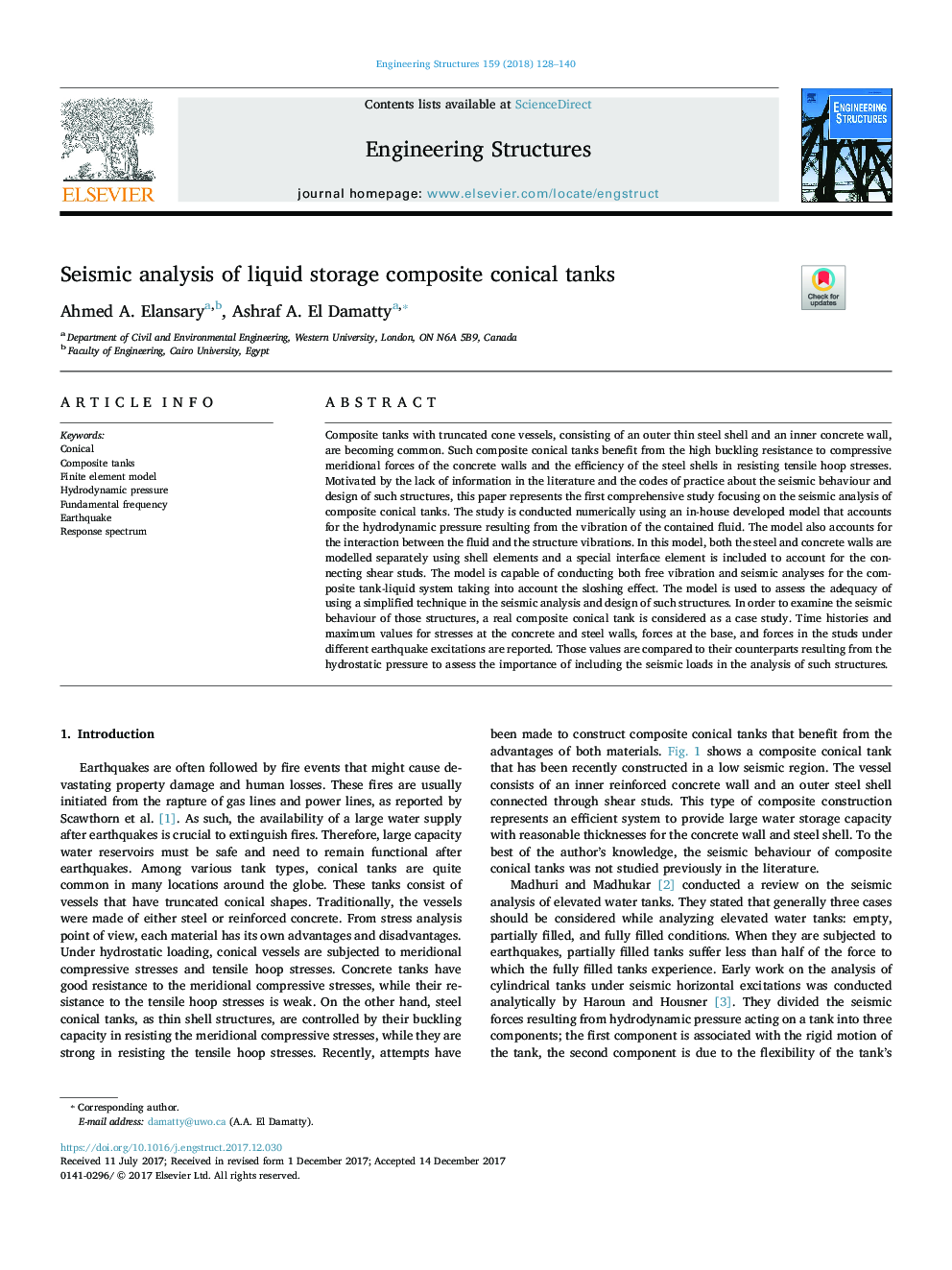| کد مقاله | کد نشریه | سال انتشار | مقاله انگلیسی | نسخه تمام متن |
|---|---|---|---|---|
| 6738486 | 1429068 | 2018 | 13 صفحه PDF | دانلود رایگان |
عنوان انگلیسی مقاله ISI
Seismic analysis of liquid storage composite conical tanks
ترجمه فارسی عنوان
تجزیه و تحلیل لرزه ای مخازن مخروطی کامپوزیت ذخیره سازی مایع
دانلود مقاله + سفارش ترجمه
دانلود مقاله ISI انگلیسی
رایگان برای ایرانیان
کلمات کلیدی
مخروطی مخازن کامپوزیتی، مدل عنصر محدود فشار هیدرودینامیکی، فرکانس اساسی، زمین لرزه، طیف پاسخ
ترجمه چکیده
مخازن کامپوزیتی با مخازن مخروطی کوتاه، شامل پوسته فولادی نازک بیرونی و دیواره داخلی بتن، در حال تبدیل شدن به رایج است. این مخازن مخروطی کامپوزیت از مقاومت بالای خمشی به نیروهای مرزی فشرده دیواره های بتنی و کارایی پوسته های فولادی در مقاومت در برابر تنش های کششی کششی بهره می برد. این مقاله با توجه به نبود اطلاعات در ادبیات و کدهای عملی در مورد رفتار لرزه ای و طراحی چنین سازه ها، این مقاله اولین مطالعات جامع را که بر روی تجزیه و تحلیل لرزه ای مخازن مخروطی کامپوزیت تمرکز دارد، نشان می دهد. این مطالعه به صورت عددی با استفاده از یک مدل توسعه یافته در داخل کشور انجام شده است که برای فشار هیدرودینامیکی ناشی از ارتعاش مایع موجود در حساب می آید. این مدل همچنین برای تعامل بین سیال و ارتعاش ساختارها مطابقت دارد. در این مدل، هر دو دیوارهای فولادی و بتونی به طور جداگانه با استفاده از عناصر پوسته پوسته شده و یک عنصر رابط کاربری ویژه برای محاسبه نرده های برشی اتصال وجود دارد. این مدل قادر است هر دو لرزش آزاد و تجزیه و تحلیل لرزه ای را برای سیستم مخزن مرکب کامپوزیت با توجه به اثر لغزش انجام دهد. این مدل برای ارزیابی کفایت استفاده از تکنیک ساده در تجزیه و تحلیل لرزه ای و طراحی چنین سازه ای استفاده می شود. به منظور بررسی رفتار لرزه ای این سازه ها، مخزن مخروطی کامپوزیت واقعی به عنوان یک مورد مورد مطالعه قرار می گیرد. تاریخچه های زمان و حداکثر مقادیر تنش در دیوارهای بتنی و فولادی، نیروها در پایه و نیروها در ناخنها تحت تحریکات مختلف زلزله گزارش شده است. این مقادیر با همتایان خود در نتیجه فشار هیدرواستاتیک مقایسه شده است تا ارزیابی اهمیت بارهای لرزه ای در تجزیه و تحلیل چنین ساختارها را ارزیابی کند.
موضوعات مرتبط
مهندسی و علوم پایه
علوم زمین و سیارات
مهندسی ژئوتکنیک و زمین شناسی مهندسی
چکیده انگلیسی
Composite tanks with truncated cone vessels, consisting of an outer thin steel shell and an inner concrete wall, are becoming common. Such composite conical tanks benefit from the high buckling resistance to compressive meridional forces of the concrete walls and the efficiency of the steel shells in resisting tensile hoop stresses. Motivated by the lack of information in the literature and the codes of practice about the seismic behaviour and design of such structures, this paper represents the first comprehensive study focusing on the seismic analysis of composite conical tanks. The study is conducted numerically using an in-house developed model that accounts for the hydrodynamic pressure resulting from the vibration of the contained fluid. The model also accounts for the interaction between the fluid and the structure vibrations. In this model, both the steel and concrete walls are modelled separately using shell elements and a special interface element is included to account for the connecting shear studs. The model is capable of conducting both free vibration and seismic analyses for the composite tank-liquid system taking into account the sloshing effect. The model is used to assess the adequacy of using a simplified technique in the seismic analysis and design of such structures. In order to examine the seismic behaviour of those structures, a real composite conical tank is considered as a case study. Time histories and maximum values for stresses at the concrete and steel walls, forces at the base, and forces in the studs under different earthquake excitations are reported. Those values are compared to their counterparts resulting from the hydrostatic pressure to assess the importance of including the seismic loads in the analysis of such structures.
ناشر
Database: Elsevier - ScienceDirect (ساینس دایرکت)
Journal: Engineering Structures - Volume 159, 15 March 2018, Pages 128-140
Journal: Engineering Structures - Volume 159, 15 March 2018, Pages 128-140
نویسندگان
Ahmed A. Elansary, Ashraf A. El Damatty,
